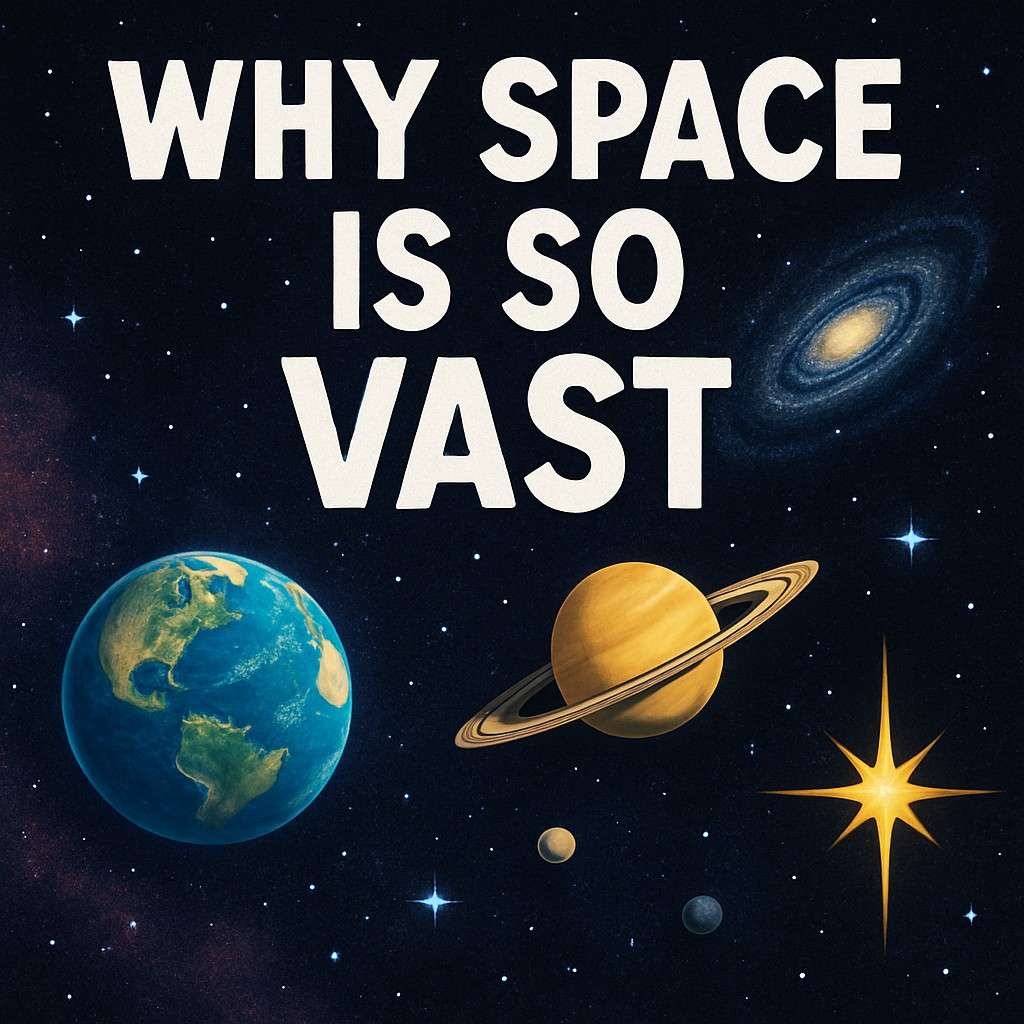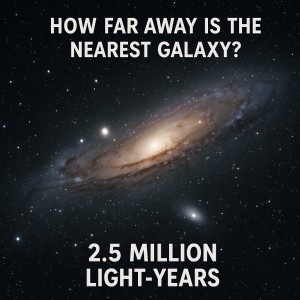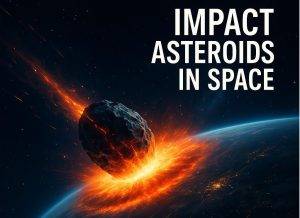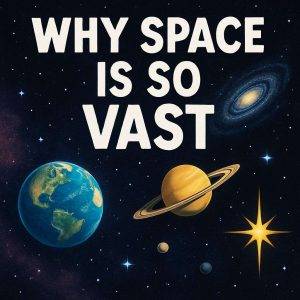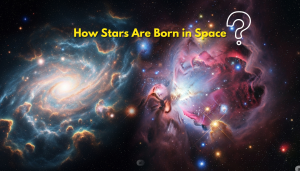Why Space Is So Vast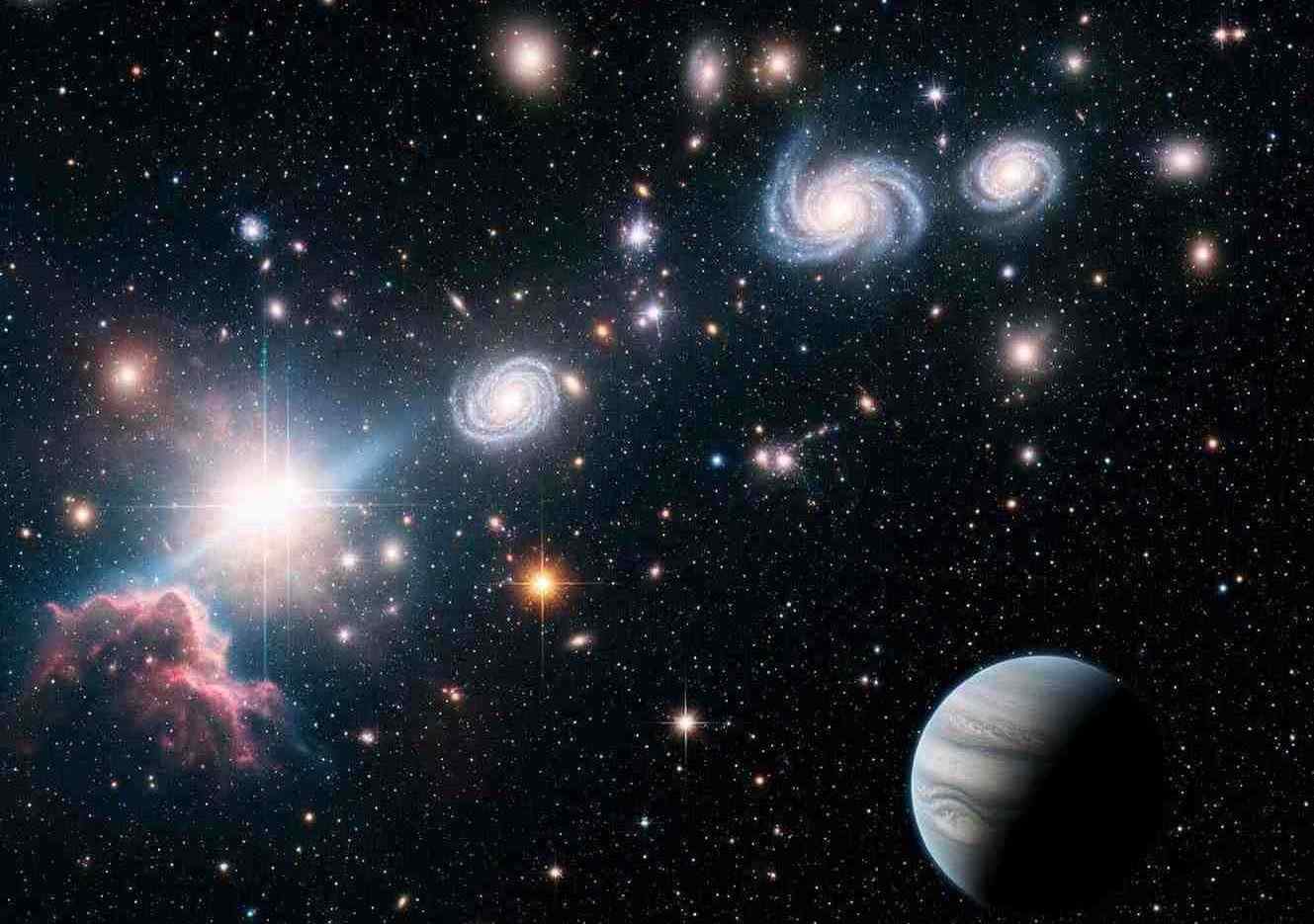
A Journey into the Infinite Cosmos
When we look up at the heavens, one of the most profound questions that arises is: “Why is space so vast?” What makes the universe so enormous, seemingly endless, and ever-expanding? The answer to this question lies at the heart of cosmology, physics, and our quest to understand our place in the cosmos. In this article, we explore the nature, origin, and implications of the vastness of space, diving deep into science, theory, and imagination.
1. The Birth of Space: The Big Bang
To understand why space is so vast, we must begin at the very beginning — the Big Bang. Approximately 13.8 billion years ago, all the matter, energy, space, and time in the universe were compressed into an unimaginably dense point called a singularity. Then, in a moment of cosmic inflation, the universe began to expand at an incredible rate.
This crucial concept helps us grasp why space today is so enormous. From that initial moment, the universe has been stretching outward, not into anything, but expanding itself.Why Space Is So Vast
2. The Nature of Space Itself ]Why Space Is So Vast
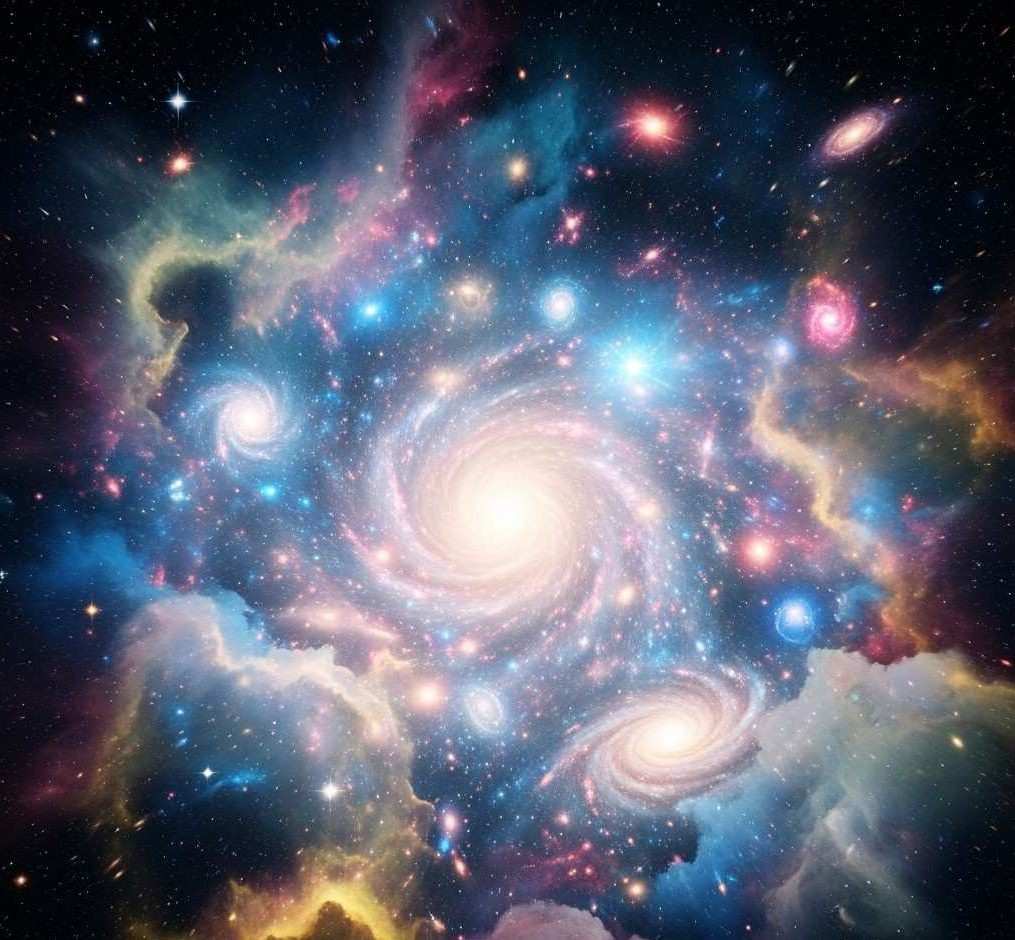
Space isn’t just empty nothingness; it’s a physical fabric that can stretch, bend, and warp. This is best explained by Einstein’s theory of General Relativity, which shows that space and time form a unified fabric known as spacetime.
This fabric is flexible. Galaxies, stars, and planets don’t move through space like boats in an ocean; instead, the ocean (space) itself expands, carrying them apart. Over billions of years, this expansion of space has led to the vast distances we now observe between cosmic objects.
3. Cosmic Inflation: The Early Growth Spurt
One of the key reasons for the vastness of space lies in the concept of cosmic inflation, a theory proposed in the 1980s by physicist Alan Guth. According to this theory, just a fraction of a second after the Big Bang, the universe underwent a period of exponential expansion, growing faster than the speed of light.
It also made the universe enormously large in a very short time, explaining the uniformity and scale we observe.
4. Space Is Still Expanding
One of the most remarkable discoveries of the 20th century, confirmed by Edwin Hubble in 1929, is that galaxies are moving away from us, and the farther away they are, the faster they are receding. This observation led to the understanding that the universe is still expanding. Why Space Is So Vast
Even more surprisingly, in the late 1990s, astronomers discovered that this expansion is accelerating, driven by an unknown force called dark energy. This mysterious energy makes up about 70% of the universe and seems to be pushing space apart at an increasing rate. As a result, space becomes even more vast with time. Why Space Is So Vast
5. The Observable Universe vs. the Entire Universe
light and the age of the universe.
However, the entire universe could be infinitely larger — possibly infinite in size. There might be regions of space beyond our observable universe that follow completely different laws of physics or contain different types of matter.
6. The Role of Time ]Why Space Is So Vast
The vastness of space is also a product of the immense timescale of the universe. Over billions of years, the slow but constant expansion of space has added up to enormous distances. Time and space are intimately connected; as the universe grows older, space grows wider.
Why Space Is So Vast
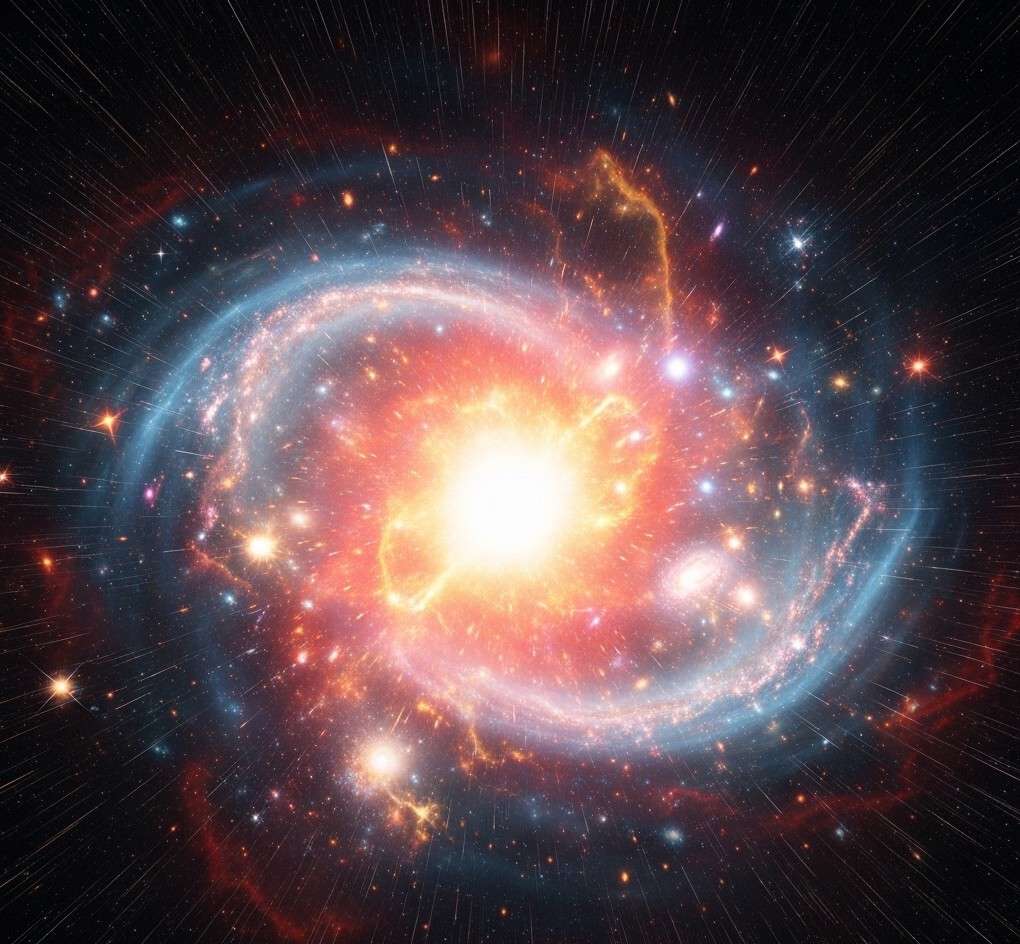
What seems vast to us now may once have been tightly packed. Given enough time, even the most minute expansion leads to unfathomable distances. This is a reminder that cosmic scales are far beyond human intuition, shaped by time spans that dwarf our own history. Why Space Is So Vast
7. Why Does Space Need to Be So Vast? ]Why Space Is So Vast
Some might wonder if there’s a reason space is vast. From a scientific perspective, the vastness isn’t about need — it’s a consequence of natural laws and cosmic evolution. However, some speculative and philosophical ideas include: Why Space Is So Vast
-
The Anthropic Principle: We exist in a universe capable of forming stars, planets, and life. A vast universe may be necessary for such complexity to arise. Why Space Is So Vast
-
Multiverse Theory: Our universe might be one of many. Perhaps each universe in the multiverse has different properties, and only some (like ours) are vast and stable enough to support observers.
-
Simulated Universe Hypothesis: A fringe but intriguing idea is that our universe is a simulation. If true, its vastness might serve a computational or experiential purpose. Why Space Is So Vast
8. The Psychological Effect of Vastness ]Why Space Is So Vast
Knowing that the closest star is over 4 light-years away and the nearest galaxy is 2.5 million light-years distant humbles us. Yet, it also fuels our desire to explore, to reach out beyond our tiny planet and understand the cosmos.
Humanity is only beginning its journey into space. The vastness of space, rather than being a limitation, may be the very thing that inspires our greatest achievements. Why Space Is So Vast
Why Is 95% of the Universe Invisible?
Yet, in all our explorations—using telescopes that peer deep into space, satellites that measure cosmic radiation, and observatories that track the motion of galaxies—we’ve stumbled upon a profound mystery: around 95% of the universe is invisible. This is not just because it is hidden from our sight, but because it is made of substances that do not emit, absorb, or reflect light in any measurable way. But what does it mean for something to be “invisible” in the context of cosmology? Why do we believe this invisible matter and energy exist if we can’t see them? Why Space Is So Vast
Let’s explore the mysterious reality behind this cosmic puzzle.
The Universe We See: Just the Tip of the Iceberg ]Why Space Is So Vast
All the stars, planets, galaxies, nebulae, gas clouds, and cosmic dust that we observe with even the most powerful telescopes account for only about 5% of the total mass-energy content of the universe. This is known as “ordinary” or “baryonic” matter—the kind that makes up everything from our bodies to the most distant galaxies.
This 5% is composed of atoms and molecules that interact with electromagnetic radiation (light), allowing us to see them with the naked eye or through instruments. However, when scientists started studying the behavior of galaxies, clusters, and the expanding universe, they noticed that something wasn’t adding up. Why Space Is So Vast
The First Clues: Galaxy Rotation and the Need for Dark Matter
In the 1970s, astronomer Vera Rubin observed that galaxies were rotating in a way that couldn’t be explained by the visible matter alone. Based on Newtonian physics, the stars on the outer edges of galaxies should be moving slower than those near the center—similar to how planets orbit the Sun. However, Rubin discovered that these outer stars were moving just as fast, indicating the presence of a huge amount of unseen mass. Why Space Is So Vast
To explain this phenomenon, scientists proposed the existence of dark matter—an invisible substance that doesn’t emit light or radiation, but exerts gravitational force. It’s like an invisible scaffolding that holds galaxies together, providing the additional mass needed to explain their motion. Why Space Is So Vast
A Greater Mystery: The Accelerating Universe and Dark Energy
As if dark matter wasn’t mysterious enough, scientists uncovered an even more puzzling phenomenon in the late 1990s. Two independent teams of astronomers studying distant Type Ia supernovae (exploding stars) discovered that the universe’s expansion was not slowing down, as expected due to gravity—it was speeding up. Why Space Is So Vast
To account for this acceleration, researchers proposed a new form of energy—called dark energy—that exerts a kind of negative pressure, pushing space apart. This energy is completely invisible and doesn’t clump like matter does, but its effects are profound. Current data from sources such as the Planck satellite and the WMAP mission suggest that dark energy makes up about 68% of the universe.
Together, dark matter and dark energy make up roughly 95% of the universe, leaving only 5% as the familiar matter we can see and touch.
Why Is This 95% Invisible? ]Why Space Is So Vast
The invisibility of dark matter and dark energy stems from their lack of interaction with electromagnetic radiation. Here’s what that means:
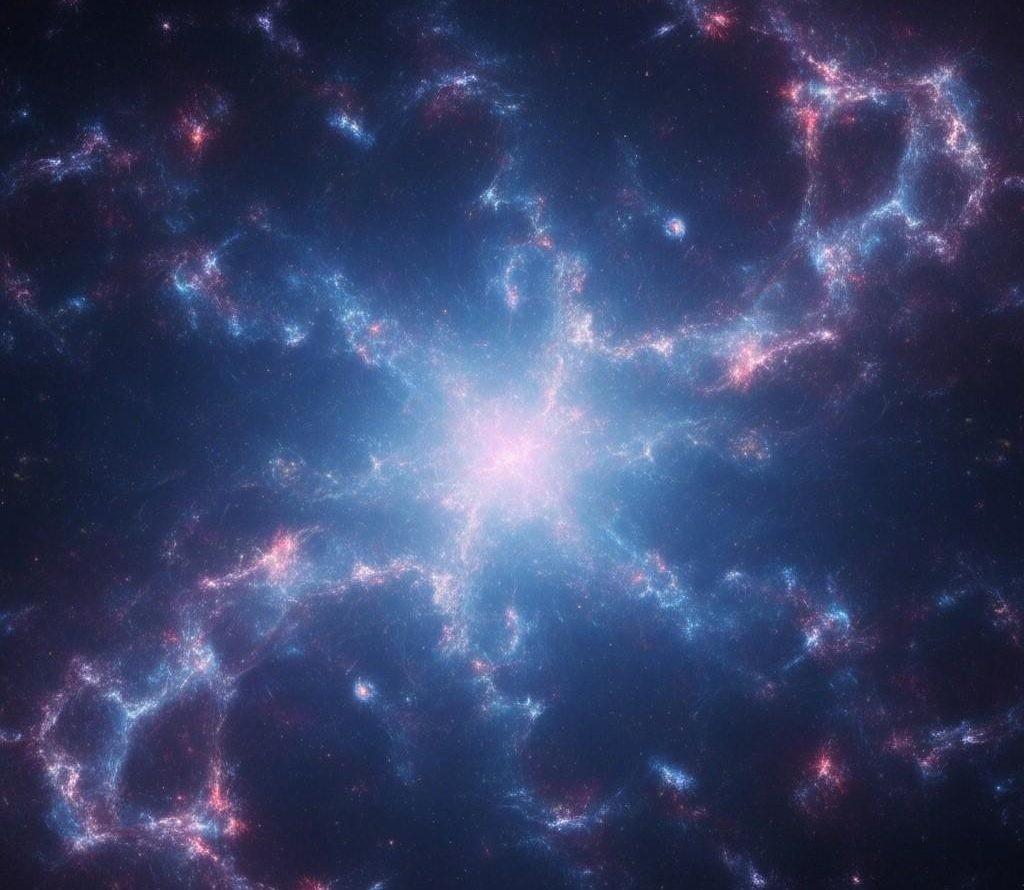
-
Dark Matter:
-
It does not emit, absorb, or reflect light.
-
It does interact with gravity—this is how we detect its presence.
-
It may consist of yet-undiscovered particles such as WIMPs (Weakly Interacting Massive Particles), axions, or sterile neutrinos.
-
It forms halos around galaxies, affecting their structure and motion. Why Space Is So Vast
-
-
Dark Energy:
-
It is even more mysterious than dark matter.
-
It is believed to be uniformly distributed throughout space.
-
It doesn’t interact with light or matter in the traditional sense, but it influences the expansion rate of the universe.
-
Because neither of these substances interacts with light or other electromagnetic waves, they are invisible to all our current optical and radio instruments. They don’t shine, cast shadows, or leave direct traces. Scientists can only infer their existence indirectly through their gravitational and cosmological effects. Why Space Is So Vast
Searching for the Invisible: How Do We Study What We Can’t See?
Despite their invisibility, scientists have developed several clever methods to study dark matter and dark energy:
Studying Dark Matter: Why Space Is So Vast
-
Cosmic Microwave Background (CMB): Small fluctuations in the CMB radiation provide clues about the presence of dark matter.
-
Particle Detectors: Underground labs are trying to detect dark matter particles directly (e.g., LUX-ZEPLIN, XENON1T).
-
Galaxy Cluster Dynamics: Observing how galaxies move within clusters reveals the gravitational pull of dark matter. Why Space Is So Vast
Studying Dark Energy:
-
Supernova Surveys: Tracking the brightness and distance of supernovae helps determine how fast the universe is expanding.
-
Baryon Acoustic Oscillations (BAO): Patterns in the large-scale structure of the universe hint at the influence of dark energy.
-
CMB Measurements: The shape and distribution of the CMB provide insight into the universe’s energy content. Why Space Is So Vast
Philosophical Implications: What Does It Mean to Be Invisible?
The realization that 95% of the universe is invisible challenges our understanding of reality itself. For centuries, science has focused on observing and understanding the visible universe. But now we know that the visible part is only a small piece of the cosmic puzzle.
This forces us to confront deeper questions:
-
What is the true nature of reality if most of it is hidden?
-
Can something exist without being directly observed?
-
Are there more invisible forces and substances waiting to be discovered?
Some even speculate that our current models are incomplete, and that dark matter and dark energy might be signs of entirely new physics—perhaps modifications to gravity or unseen dimensions. Why Space Is So Vast
What Does Vast Mean in Space?
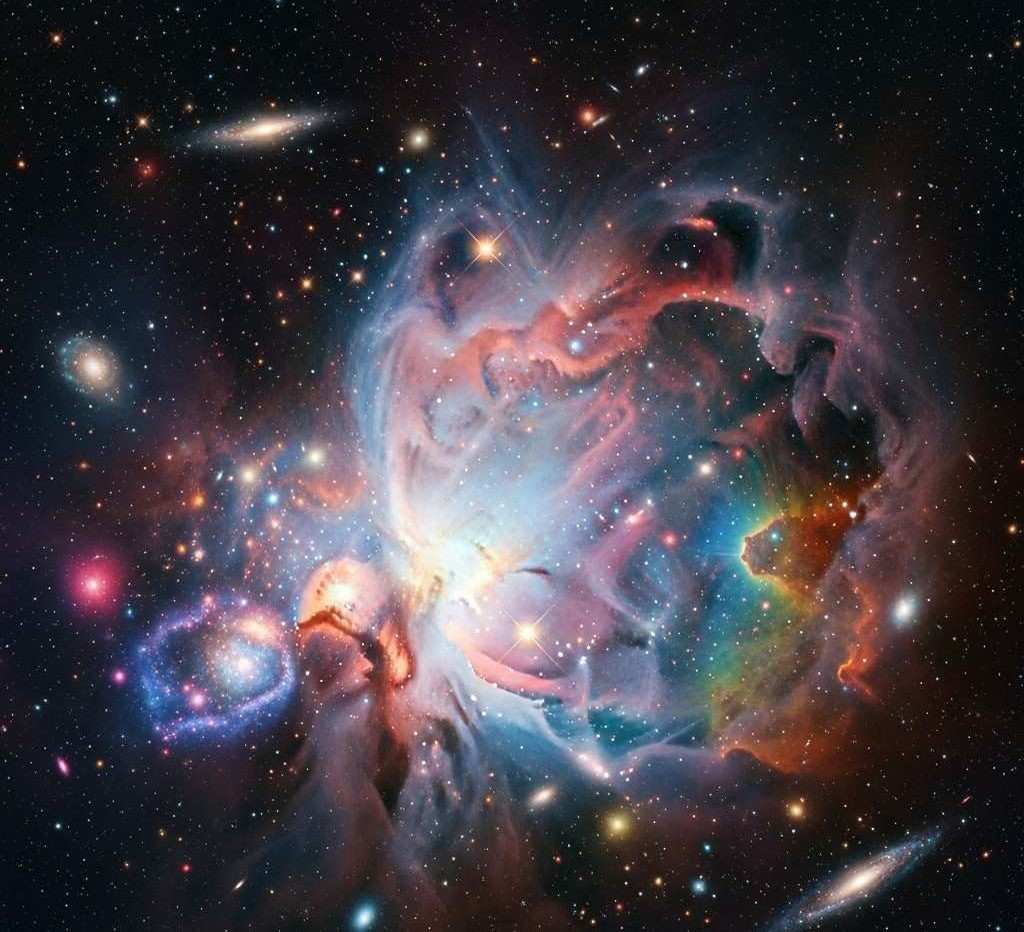 But when the word is used in the context of space, its meaning expands beyond anything we encounter in our daily lives. “Vast” in space signifies a scale that is so immense, so incomprehensibly large, that it challenges the limits of human imagination and understanding. In this article, we will explore what “vast” truly means when talking about space, using real scientific concepts, numbers, and perspectives to grasp the incredible size and structure of the universe.
But when the word is used in the context of space, its meaning expands beyond anything we encounter in our daily lives. “Vast” in space signifies a scale that is so immense, so incomprehensibly large, that it challenges the limits of human imagination and understanding. In this article, we will explore what “vast” truly means when talking about space, using real scientific concepts, numbers, and perspectives to grasp the incredible size and structure of the universe.
Understanding “Vast” in Simple Terms
The dictionary defines vast as something of very great extent or size; immense. In space, that immensity reaches levels that are not just large—they are mind-boggling. Why Space Is So Vast
That already seems far. But the distance from Earth to the Sun is around 150 million kilometers (93 million miles)—almost 400 times farther.
Distances in Space: From Planets to Stars
Let’s talk about some numbers that define the “vastness” of space:
-
In a year, it travels roughly 9.46 trillion kilometers (5.88 trillion miles).
-
Why Space Is So Vast That means even if we could travel at the speed of light, it would take more than 4 years to reach it.
-
Our Milky Way galaxy is about 100,000 light-years in diameter and contains over 100 billion stars.
-
The observable universe has a diameter of around 93 billion light-years and contains at least 2 trillion galaxies.
When we say “vast,” we are referring to these immense scales—distances and quantities that are simply beyond ordinary comprehension.
The Structure of the Universe: Layers of Vastness
To understand how vast space truly is, we can look at it in layers:
1. Our Solar System Why Space Is So Vast
2. Our Galaxy: The Milky Way
-
Home to billions of planetary systems. Why Space Is So Vast
3. The Local Group
-
A small group of about 54 galaxies, including the Milky Way, Andromeda, and the Magellanic Clouds.
-
Spanning 10 million light-years across.
4. The Universe Why Space Is So Vast
Vastness in Time and Age
Vast doesn’t only apply to size. In space, it also refers to time.
-
The universe is about 13.8 billion years old.
-
Light from distant galaxies takes billions of years to reach us, meaning when we look at them, we see them as they were billions of years ago.
-
Some stars we see today may have already burned out, but their light is still traveling toward us. Why Space Is So VastWhy Space Is So Vast
This sense of deep time, combined with massive distances, gives space a level of vastness that operates on both spatial and temporal scales.
Human Perspective vs Cosmic Vastness
It’s easy to feel small when thinking about space. The solar system is a speck in the galaxy. The galaxy is just one among trillions. And yet, we are here, trying to understand it all.
-
Our potential: How incredible it is that humans—tiny beings on a small planet—can observe, measure, and even explore the vastness of the universe.
Technological Achievements in Vast Space
Despite the vastness, humans have made incredible strides:
-
The Voyager 1 spacecraft has traveled over 24 billion kilometers since its launch in 1977 and is now in interstellar space.
-
Telescopes like the James Webb Space Telescope allow us to see galaxies billions of light-years away, giving us a glimpse into the early universe.
-
Future missions aim to explore exoplanets, search for life, and perhaps even send humans to Mars or beyond.
These efforts show our desire to explore and understand the infinite spaces beyond our world.
The idea that 1 hour in space equals 7 years on Earth has captured the public imagination, particularly after being dramatically depicted in the science fiction film Interstellar (2014). In the movie, astronauts visit a planet near a massive black hole named Gargantua, and due to the intense gravity, time moves much slower for them. When they return to their ship after a short mission, they discover that many years have passed for those who remained farther away. This portrayal sparked widespread curiosity and confusion: Can such a thing really happen?
The short answer is: yes, but only under very specific and extreme conditions. Let’s explore the science behind this fascinating concept and understand when and how such time distortion could actually occur.
Understanding Time Dilation: Einstein’s Theory of Relativity
To grasp this phenomenon, we must first understand a key concept from Albert Einstein’s General Theory of Relativity—time dilation. Instead, it can speed up or slow down depending on gravity (gravitational time dilation) or speed (special relativistic time dilation).
1. Gravitational Time Dilation
-
Time moves slower in stronger gravitational fields.
-
The closer you are to a massive object, like a black hole, the more slowly time passes for you relative to someone farther away.
This is not science fiction—it’s a measurable effect. Experiments involving atomic clocks on satellites and the Earth’s surface have confirmed that clocks run slightly faster in weaker gravitational fields (like in orbit) than they do on Earth.
2. Special Relativistic Time Dilation
-
When you travel at speeds close to the speed of light, time for you slows down compared to someone who is stationary.
-
This is the basis of the famous “twin paradox” in relativity theory.
Both these forms of time dilation are real, measurable, and verified by many experiments, especially involving GPS satellites, particle physics, and cosmic rays.
The “Interstellar” Scenario: Fact or Fiction?
In Interstellar, a scene depicts astronauts landing on a planet orbiting very close to a massive black hole, where 1 hour on the planet equals 7 years for someone farther away.
Is this possible?
The Science Behind It
Yes, it is theoretically possible under extreme conditions:
-
The black hole must be enormously massive (like Gargantua, which is a rotating supermassive black hole with 100 million solar masses).
-
The astronauts must be very close to the event horizon, where the gravitational field is strongest.
Under such extreme gravitational time dilation, 1 hour for those near the black hole could indeed equal 7 years for someone farther away, like on Earth.
Realistic or Not?
While it’s theoretically accurate, achieving such exact conditions is highly unlikely in the real universe:
-
Any planet that close to a black hole might be uninhabitable due to intense tidal forces and radiation.
-
The physics used in Interstellar was developed with the help of renowned physicist Kip Thorne, who won a Nobel Prize in Physics and ensured that the movie stayed as scientifically accurate as possible.
So while it’s based on real science, it’s an extreme and rare case, more likely to be found in theoretical physics than in practical exploration.
Everyday Time Dilation in Space
Even if we can’t experience the “1 hour = 7 years” ratio under normal space conditions, time dilation does occur in ways that we can measure.
Examples:
-
Astronauts on the International Space Station (ISS) age slightly slower than people on Earth due to both speed and weaker gravity.
-
The effect is minuscule—only a few milliseconds difference after spending months in space.
-
GPS satellites must correct their onboard clocks because they experience both types of time dilation—moving fast and being farther from Earth’s gravity.
These effects are small but critical for systems like GPS to function accurately. Why Space Is So Vast
Time Dilation and the Future of Space Travel ] Why Space Is So Vast
As we explore deeper into space and consider traveling at near-light speeds, time dilation becomes a practical consideration.
The “Twin Paradox” in Real Life:
Imagine one twin travels on a spacecraft at nearly the speed of light for several years, while the other remains on Earth. Upon return, the traveling twin would be significantly younger than their sibling.
In the distant future, if humans build ships capable of relativistic speeds (close to the speed of light), astronauts could potentially experience just a few years of travel, while decades or centuries pass on Earth.
Philosophical and Emotional Implications
Beyond the physics, time dilation raises emotional and philosophical questions:
-
What does it mean to leave your loved ones behind, knowing time passes differently for you?
The answer is yes. Gravitational and special relativity-based time dilation are both real-world methods of “time travel into the future.”
What Does Vast Mean in Space?
When we hear the word “vast,” our minds often turn to images of great deserts, endless oceans, or towering mountain ranges. But in the context of space, vast takes on an entirely new dimension—one that stretches far beyond the limits of human comprehension. Space isn’t just big; it is staggeringly, unfathomably immense. In fact, the term “vast” might be one of the few human words that even comes close to capturing the scale of the universe. Why Space Is So Vast
Defining “Vast”
It conveys a sense of enormity that is difficult to measure or grasp. But when applied to space, this definition reaches a level of scale that defies intuition. The universe is not simply large like a mountain or even a planet—it is limitless to our senses, stretching across distances that can only be measured in light-years, with Why Space Is So Vast
The Observable Universe: A Glimpse of Vastness
To begin to understand how vast space really is, let’s look at what scientists call the observable universe. This refers to the portion of the entire universe that we can see, detect, or study using current technology. It extends about 46.5 billion light-years in every direction from Earth. That means the total diameter of the observable universe is about 93 billion light-years.
But what is a light-year? Multiply that by 93 billion, and the numbers become so large they are almost meaningless in everyday terms. Even if we had the fastest spacecraft ever made, it would still take tens of thousands of years just to leave our own solar system. And the universe continues far beyond what we can currently observe. Why Space Is So Vast
Galaxies Within Galaxies Why Space Is So Vast
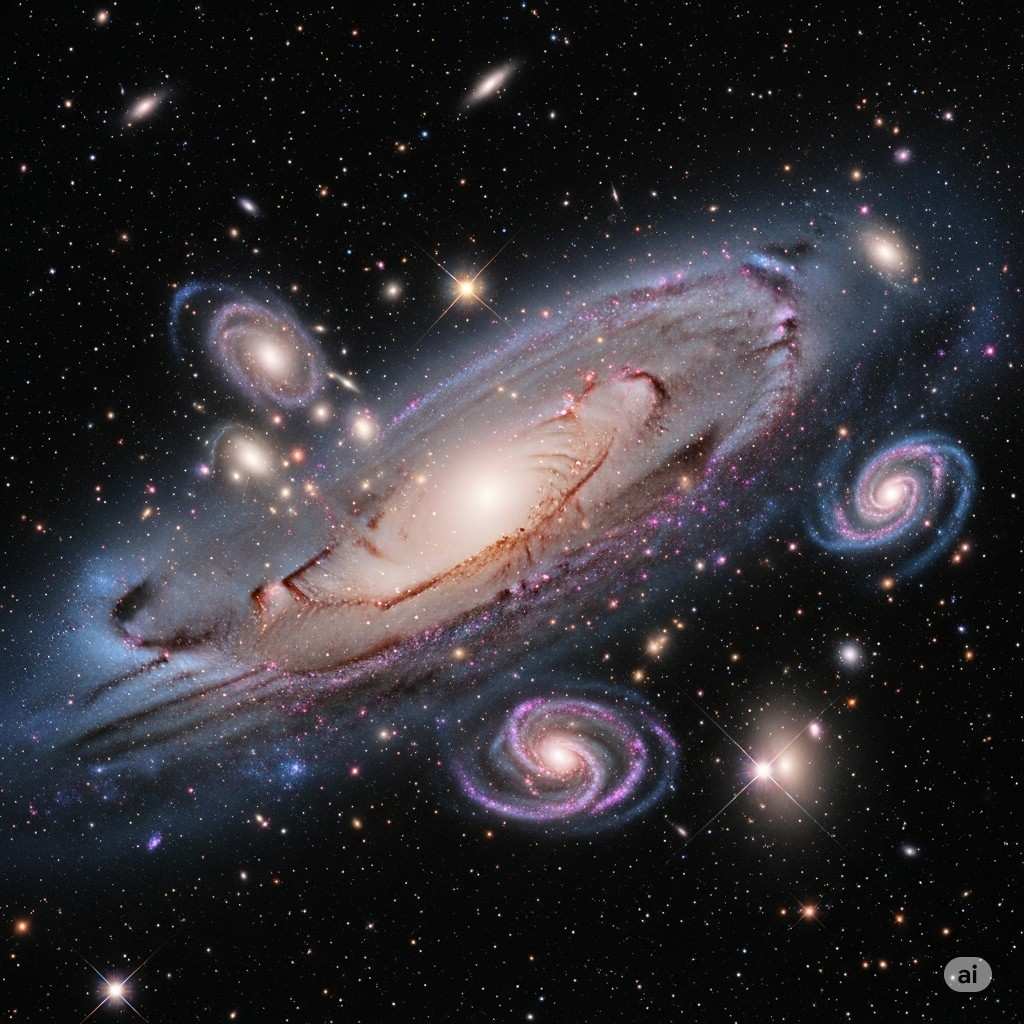
Our galaxy, the Milky Way, contains around 100 to 400 billion stars, and it is only one of an estimated two trillion galaxies in the observable universe. These galaxies are separated by unimaginable distances. For instance, our nearest large galactic neighbor, the Andromeda Galaxy, is about 2.5 million light-years away. That’s not two and a half million kilometers or even miles—it’s light-years.
Even more astonishing is that between these galaxies lies mostly empty space. And yet, this empty space isn’t truly empty—it is filled with dark matter, radiation, magnetic fields, and the fabric of spacetime itself. So even the so-called “nothingness” of space contributes to its vastness.
Vastness in Time Why Space Is So Vast
The vastness of space is not only measured in distance—it’s also deeply connected to time. The universe is around 13.8 billion years old, and the light we see from the farthest galaxies started traveling toward us billions of years ago. When you gaze at the night sky, some of the starlight that reaches your eyes is older than human civilization itself.
Moreover, the universe is still expanding. Every second, galaxies move farther away from one another due to the ongoing expansion of space. That means the universe is not just vast—it’s becoming vaster all the time.
Human Perspective vs Cosmic Scale Why Space Is So Vast
From a human perspective, Earth feels immense. Current space technology would take thousands of years to get there.
This contrast between our daily experiences and the scale of the universe shows just how small we really are. Our entire history as a species is a blink in cosmic time. The scale of the universe is so large that most of it will forever remain out of reach, and possibly out of understanding, for human beings. Why Space Is So Vast
Why Understanding Vastness Matters
Understanding the vastness of space is not just an academic exercise—it changes how we see ourselves and our place in the universe. It inspires humility, curiosity, and a deep sense of wonder. Scientists, astronomers, and philosophers have long pondered what this vastness means. Are we alone in such a large cosmos? Is our planet just one of countless others that could host life? These questions arise because of the vastness.
With tools like the Hubble Space Telescope, the James Webb Space Telescope, and powerful radio telescopes on Earth, we can peer deeper into the cosmos than ever before. Each new discovery reveals just how much more there is to explore and understand.
Is Space Endless or Infinite? ]Why Space Is So Vast
This question lies at the very intersection of philosophy, physics, cosmology, and human curiosity.
Understanding the Concept of Space
To explore whether space is endless or infinite, we first need to define what we mean by “space.” In the context of cosmology, space refers to the three-dimensional fabric in which all matter exists. This includes planets, stars, galaxies, and even the seemingly empty voids between them. Why Space Is So Vast
Space is not static. According to Einstein’s theory of general relativity, space is dynamic and can expand, bend, and curve in response to matter and energy. The discovery that the universe is expanding — confirmed by Edwin Hubble in the 1920s — added a layer of complexity to our understanding of space. But it also raised a deeper question: If space is expanding, what is it expanding into? And does it have a boundary? Why Space Is So Vast
The Observable Universe vs. the Whole Universe
One of the most important distinctions in this discussion is between the observable universe and the entire universe. 13.8 billion years ago. This makes the observable universe roughly 93 billion light-years in diameter.
But beyond that? We don’t know for sure. Why Space Is So Vast
There could be vastly more universe — or even an infinite expanse — beyond what we can observe. However, due to the limitations of the speed of light and the expansion of space itself, we may never be able to detect or understand what lies beyond our observational horizon.
What Does “Infinite” Mean in Cosmology?
Infinity in a mathematical or philosophical sense means something that has no bounds or limits. When applied to space, it implies that the universe extends forever in all directions without edge or boundary. But in cosmology, the term “infinite” becomes a lot more complex. There are several possible interpretations: Why Space Is So Vast
-
Spatial Infinity: This suggests that if you could travel far enough in a straight line through space, you would never reach an edge or a wall — you’d just keep going forever.
-
Temporal Infinity: Not only is space infinite, but time itself may have no beginning or end.
-
Multiverse Theories: Some cosmologists propose that our universe is just one of countless “bubble universes” in a multiverse. Each bubble might be finite or infinite, and the collection might be endless in scope.
Models of the Universe: Finite or Infinite?
Modern cosmology presents several models of the universe based on the curvature of space, which is determined by the density of matter and energy:
1. Flat Universe (Euclidean Geometry)
This is the model most supported by current observations from the cosmic microwave background (CMB). If it’s finite, it would be analogous to a video game map that loops — you could, in theory, travel far enough in one direction and end up where you started.
2. Open Universe (Negative Curvature)
In this model, space is shaped like a hyperbolic surface — similar to a saddle. This kind of universe would be infinite and expand forever.
3. Closed Universe (Positive Curvature)
A closed universe would be like the surface of a sphere.This kind of universe might eventually stop expanding and begin contracting in a “big crunch.”
So, depending on the curvature, space could be infinite, or it could be finite but without boundaries.
Scientific Evidence So Far ]Why Space Is So Vast
Cosmic measurements taken by satellites such as WMAP and Planck have provided the most accurate data about the shape and structure of the universe. This doesn’t conclusively prove the universe is infinite, but it does make a strong case for it.
Additionally, the cosmic microwave background radiation — the afterglow of the Big Bang — shows a uniformity that hints at a very large, possibly infinite universe. Why Space Is So Vast
However, it’s worth noting that we may never be able to observe the entire universe. The edge of the observable universe is not the edge of all existence — just the limit of what we can currently see. Why Space Is So Vast
Philosophical and Theological Implications
The idea of an infinite universe challenges our basic understanding of reality. Philosophically, infinity is difficult to comprehend because it’s not something we encounter in daily life. Why Space Is So Vast
Some theologians argue that the idea of an infinite universe aligns with certain religious beliefs about the infinite nature of the divine. Others argue that a finite, created universe is more compatible with a designed cosmos.
In either case, the question of whether space is infinite touches on deep existential mysteries about where we come from and what lies beyond.
Could the Universe Be a Simulation? ]Why Space Is So Vast
In recent years, the “simulation hypothesis” — the idea that the universe is an artificial construct, possibly run on some advanced computer — has gained attention. In such a scenario, space would be finite, limited by the capacity of the system running the simulation. This concept is speculative and more philosophical than scientific, but it offers another way to think about the “limits” of space.
The Human Perspective: Embracing the Unknown
Perhaps what makes the question — “Is space endless or infinite? Whether the universe is infinite or simply vast beyond measure, the human mind can barely grasp its full scale. And yet, we continue to ask, to explore, to dream. Why Space Is So Vast
Astronomy and cosmology are not just scientific pursuits — they are also expressions of human wonder. They reveal how little we know, and how much more there is to learn, Why Space Is So Vast
What Is Space?
Space is not just “nothingness” or a void between celestial bodies. Space is the arena in which all cosmic events occur—from the motion of planets and the birth of stars to the swirling dance of galaxies. Why Space Is So Vast
This spacetime can bend, curve, and stretch, especially in the presence of massive objects like black holes.
Is Space Finite or Infinite? Why Space Is So Vast
The question of whether space can ever end leads to two fundamental possibilities: space is either finite (it has an end or a boundary), or it is infinite (it goes on forever).
1. The Infinite Universe Hypothesis
According to this view, the universe has no edge or boundary; it extends forever in all directions. If you could travel forever in a straight line, you would never hit a wall—you’d simply keep going.
This idea fits with the standard cosmological model known as the Lambda Cold Dark Matter model (ΛCDM), which describes an expanding universe governed by dark energy and dark matter. In this model, current observations suggest the universe is “flat” geometrically, which aligns with the possibility of infinite space. Why Space Is So Vast
However, infinite doesn’t necessarily mean everything exists in it. It just means there is no known limit to its extent.
2. The Finite Universe Hypothesis Why Space Is So Vast
On the other hand, some models suggest that the universe might be finite but unbounded. You can walk in any direction indefinitely and never fall off. In this analogy, the universe could be curved in higher dimensions, looping back on itself in a way that avoids having a true “end.” Why Space Is So Vast
If space is like that, you might eventually end up where you started after traveling far enough—like flying around the Earth and returning to your starting point. Why Space Is So Vast
What Happens at the “End” of Space—If It Exists?
Assuming there is an end to space, what would it look like? Would there be a wall? A barrier? A sign that says “Universe Ends Here”?
Most physicists reject the idea of a physical boundary. The laws of physics don’t support a scenario where space just stops. Instead, if space is finite, it likely has a topology that avoids edges altogether. But if it did end, what would lie beyond? Another dimension? Nothingness? Something entirely unimaginable?
These questions drift into metaphysical territory, where scientific measurement and philosophical speculation collide. Why Space Is So Vast
The Expanding Universe
This doesn’t mean galaxies are flying through space like shrapnel from an explosion. Instead, space itself is growing—expanding between galaxies. Why Space Is So Vast
This expansion raises a fascinating question: What is space expanding into?
The short answer is: it’s not expanding into anything. Rather, new space is forming between regions of the universe, and this expansion occurs uniformly. There is no “outside” into which the universe is growing—space simply creates more of itself as time goes on. This idea is extremely counterintuitive but has strong mathematical and observational support.
The Role of the Observable Universe
This region is about 93 billion light-years across.
But the universe itself may be much larger than the observable part—potentially infinite. The limitation isn’t on space itself but on our ability to see it. Beyond the cosmic horizon, there may be more galaxies, stars, and possibly even versions of ourselves. Why Space Is So Vast
What Do Scientists Think?
The prevailing view among cosmologists is agnostic but leans toward the idea that space does not end in any traditional sense. Whether it is infinite or finite without boundaries, modern physics finds no evidence of an “edge.”
Still, this is not a settled question. New discoveries in dark energy, quantum gravity, and the structure of spacetime may one day reshape our understanding. Theories such as string theory or the multiverse hypothesis suggest our universe might be part of a larger “megaverse,” but these ideas remain speculative. Why Space Is So Vast
Philosophical Implications Why Space Is So Vast
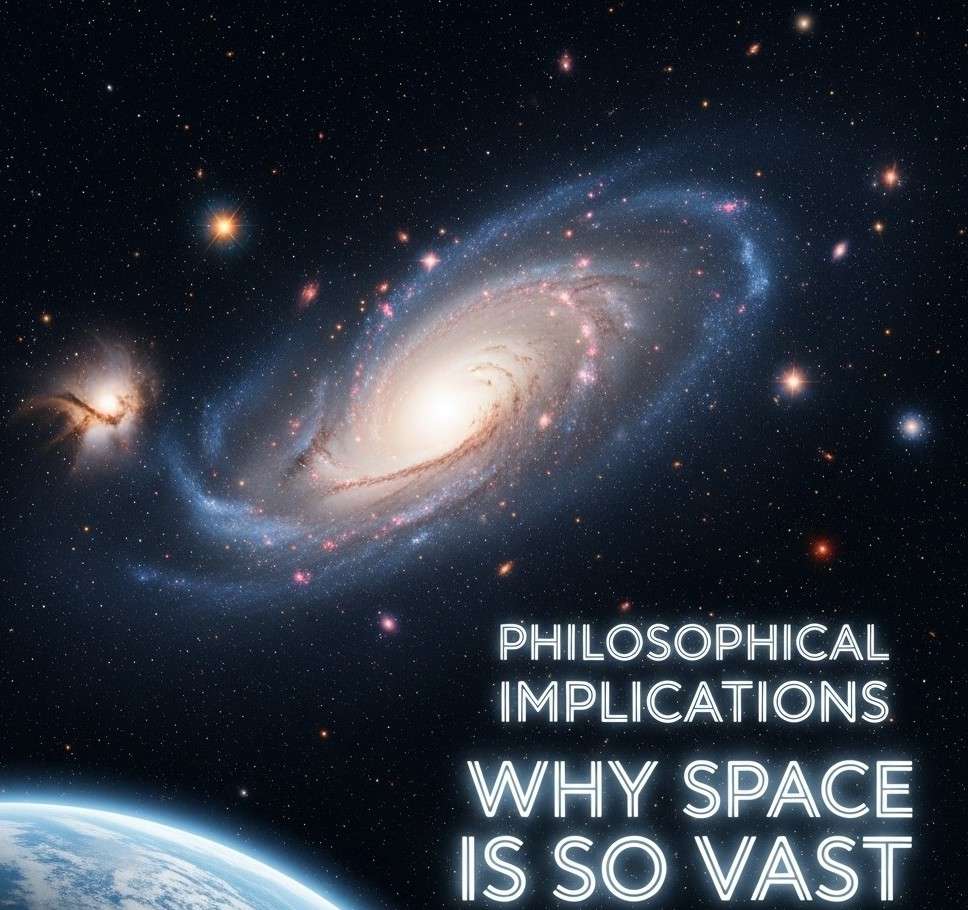
The question “Can space ever end?” also brings philosophical questions: If space ends, where is that “end”? Can the human mind grasp such a concept? What does “nothingness” mean in a physical context?
These aren’t just abstract questions. They influence how we understand our place in the cosmos. Whether space is infinite or finite, whether it ends or loops back, one thing remains clear: the universe is vast beyond imagination, and our understanding is still evolving.
Who Created Space? ]Why Space Is So Vast
The question “Who created space?” is as old as human curiosity itself. Space, the vast and seemingly infinite expanse that contains galaxies, stars, planets, and all matter, has fascinated thinkers, scientists, theologians, and philosophers for millennia. Understanding its origin challenges not only the boundaries of scientific knowledge but also touches upon deep metaphysical and spiritual ideas. This article explores various perspectives—scientific, religious, and philosophical—on the creation of space and attempts to provide a comprehensive view of this profound question.
Scientific Perspective: The Big Bang Theory
From a scientific standpoint, the most widely accepted explanation for the origin of space is the Big Bang Theory.
➤ What Happened in the Big Bang?
Contrary to popular belief, the Big Bang was not an explosion in space—it was an expansion of space itself. There was no “outside” into which the universe expanded; rather, the fabric of space-time itself was stretching. This means that space was not created in a location—it was the location. Why Space Is So Vast
The Big Bang didn’t just create matter and energy—it created space and time. This view is supported by Einstein’s theory of general relativity, which links the geometry of space with the distribution of mass and energy. Why Space Is So Vast
➤ What Came Before the Big Bang?
This is where things become speculative. Physicists like Stephen Hawking proposed that time itself began with the Big Bang, so asking “what came before” may be meaningless in the traditional sense. However, newer theories, like those involving quantum gravity, suggest that there could have been a previous state or even other universes.
Philosophical Interpretations
Philosophers have long grappled with the idea of space—what it is, whether it is something that exists independently, and how it came to be.
➤ Absolute vs. Relational Space
The philosopher Isaac Newton viewed space as an absolute entity—a real, existing framework within which objects reside and events happen. In contrast, Gottfried Wilhelm Leibniz argued for a relational view—space exists only as the distance or relation between objects.
In this context, asking “Who created space?” becomes tricky. If it is relational, it might simply be a concept that arises when objects exist.
Religious and Theological Views
Every major religion offers its own explanation for the creation of space and the universe. These views usually center around the belief in a divine creator or supreme being.
➤ Christianity
In the Bible, the Book of Genesis states:
This passage is interpreted by many as God creating space (heavens) and matter (earth). In Christian theology, God exists outside of space and time, meaning He did not come into being but always existed, and created space as part of His divine plan.
➤ Islam
The Qur’an also emphasizes that Allah is the creator of the heavens and the earth:
Here, the “heavens” are often interpreted as multiple levels of space, possibly representing the vastness of the universe. Like in Christianity, God is eternal and unbound by time and space.
➤ Hinduism
Space is believed to be created by Brahma, the creator god, and eventually destroyed by Shiva. The Vedas and Upanishads describe space (ākāśa) as one of the five fundamental elements, existing as a medium for sound and consciousness.
Unlike Western religious views, Hinduism suggests that the universe—including space—has no absolute beginning or end but moves in repeating cycles.
➤ Buddhism
Buddhism tends to avoid discussing a creator god. Instead, it focuses on dependent origination—the idea that everything arises due to causes and conditions. Space, in Buddhist thought, is not a thing created by a deity but an aspect of reality that arises as part of the cycle of existence.
Modern Cosmology and Multiverse Theories
Recent developments in theoretical physics suggest that our universe might not be the only one. The multiverse theory posits that our universe, with its own space-time fabric, could be one of countless others, each with different laws of physics.
In some versions of the theory, space is constantly being created in “bubbles” of inflation, forming new universes. This raises the question: if space is being created continually, who or what governs that process? Is it random? Is there a higher principle or intelligence behind it?
While multiverse theories are still speculative and unproven, they offer fascinating insights into how space might not be a one-time creation but a repeating or infinite process.
Could Space Be an Illusion?
Some physicists and philosophers entertain the possibility that space is not fundamental at all. Theories in quantum gravity and string theory suggest that space may be a derived property from more basic information or mathematical structures.
For example, the holographic principle suggests that the three-dimensional universe (including space) is a projection of information encoded on a two-dimensional surface. If true, space might not even be real in the way we think—it could be emergent.
This takes the question to another level: if space is an illusion, then does it need to be created at all, or is it a byproduct of something deeper?
